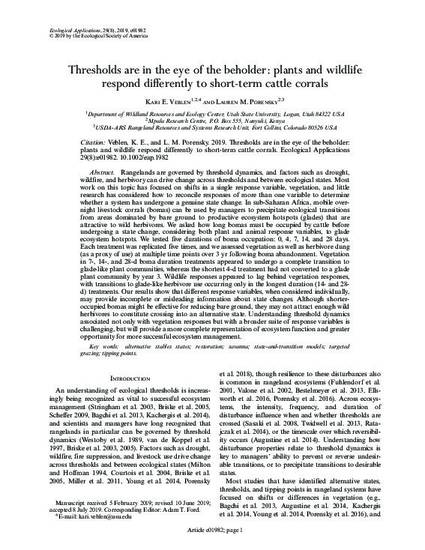
Article
Thresholds are in the eye of the beholder: plants and wildlife respond differently to short-term cattle corrals
Ecological Applications
(2019)
Abstract
Rangelands are governed by threshold dynamics, and factors such as drought,
wildfire, and herbivory can drive change across thresholds and between ecological states. Most
work on this topic has focused on shifts in a single response variable, vegetation, and little
research has considered how to reconcile responses of more than one variable to determine
whether a system has undergone a genuine state change. In sub-Saharan Africa, mobile overnight
livestock corrals (bomas) can be used by managers to precipitate ecological transitions
from areas dominated by bare ground to productive ecosystem hotspots (glades) that are
attractive to wild herbivores. We asked how long bomas must be occupied by cattle before
undergoing a state change, considering both plant and animal response variables, to glade
ecosystem hotspots. We tested five durations of boma occupation: 0, 4, 7, 14, and 28 days.
Each treatment was replicated five times, and we assessed vegetation as well as herbivore dung
(as a proxy of use) at multiple time points over 3 yr following boma abandonment. Vegetation
in 7-, 14-, and 28-d boma duration treatments appeared to undergo a complete transition to
glade-like plant communities, whereas the shortest 4-d treatment had not converted to a glade
plant community by year 3. Wildlife responses appeared to lag behind vegetation responses,
with transitions to glade-like herbivore use occurring only in the longest duration (14- and 28-
d) treatments. Our results show that different response variables, when considered individually,
may provide incomplete or misleading information about state changes. Although shorteroccupied
bomas might be effective for reducing bare ground, they may not attract enough wild
herbivores to constitute crossing into an alternative state. Understanding threshold dynamics
associated not only with vegetation responses but with a broader suite of response variables is
challenging, but will provide a more complete representation of ecosystem function and greater
opportunity for more successful ecosystem management.
Keywords
- alternative stables states; restoration; savanna; state-and-transition models; targeted grazing; tipping points.
Disciplines
Publication Date
2019
DOI
https://doi.org/10.1002/eap.1982
Citation Information
Kari E. Veblen. "Thresholds are in the eye of the beholder: plants and wildlife respond differently to short-term cattle corrals" Ecological Applications (2019) Available at: http://works.bepress.com/kari_veblen/101/
